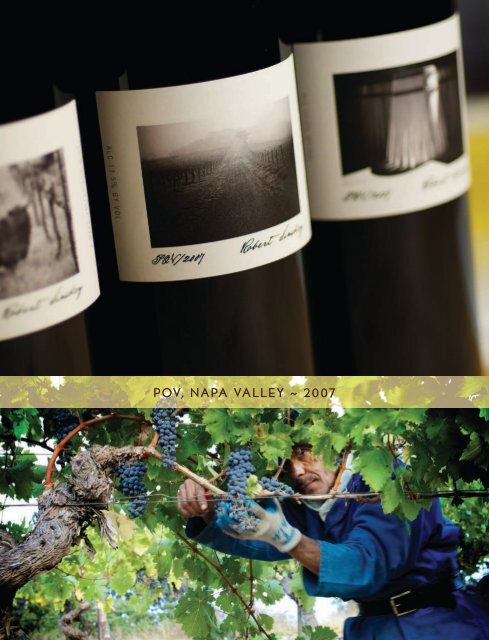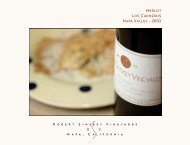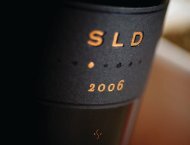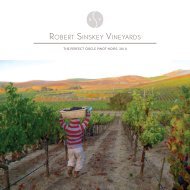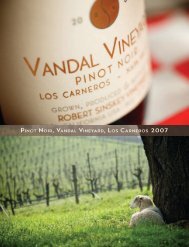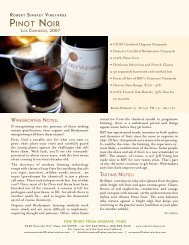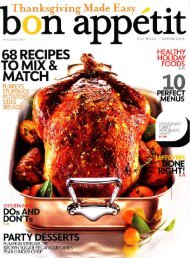POV, NAPA VALLEY ~ 2007 - Robert Sinskey Vineyards
POV, NAPA VALLEY ~ 2007 - Robert Sinskey Vineyards
POV, NAPA VALLEY ~ 2007 - Robert Sinskey Vineyards
You also want an ePaper? Increase the reach of your titles
YUMPU automatically turns print PDFs into web optimized ePapers that Google loves.
<strong>POV</strong>, <strong>NAPA</strong> <strong>VALLEY</strong> ~ <strong>2007</strong>
Well, you’re right, I’m left,<br />
and she’s gone!<br />
Wine Wars in the New World...<br />
Rob <strong>Sinskey</strong><br />
Why are some people threatened by the convictions of others? Almost every day,<br />
the media exposes us to extremist spawned hostilities in far off lands. The nature of<br />
the “us versus them, all or nothing” attitude foments a type of intolerance that I find<br />
difficult to comprehend. Though we are fortunate to live in a country that allows healthy<br />
debate, we are not immune to the wrath of the extremist.<br />
Though some people, particularly the French, might consider wine a religious<br />
experience worth fighting for, in this case I am not alluding to religious intolerance, but<br />
rather why some people are threatened by the way other people farm or make wine. Is<br />
it worth the energy to denigrate others in order to make oneself feel superior or is the<br />
real threat financial in nature?<br />
Recently, a winemaker created a blog titled “Biodynamics is a Hoax.” Predictably,<br />
its purpose is to attack or mock the rituals of Biodynamic farmers. I have to say, we<br />
might make easy targets, but do we deserve vitriol from a fellow winemaker who<br />
claims to be a sustainable farmer? What does he have to gain by putting others down?<br />
The wine industry is at a tipping point. It does not know how to define, or<br />
redefine, itself. Many believe that fine wine should be artisanal; however, many<br />
New World wines abandoned authenticity in favor of technological proficiency.<br />
As the technician replaced the artisan, more wines achieved a level of competency<br />
that emulated highly rated wines. Initially, these wines enjoyed success, but now<br />
these “manufactured for market” wines are struggling to differentiate themselves, no<br />
longer unique enough to command a price premium. If technology can assist a wine in<br />
emulating the best of the recent past, what differentiates modern wine?<br />
Not too long ago, place, conditions, and a bit of luck determined wine quality.<br />
Some places, by the nature of climate, soil as well as favorable environmental conditions<br />
during the fermentation process, consistently produced expressive and elegant wines.<br />
These site-specific wines came to define quality. A good wine was pure, it was right<br />
2 | <strong>POV</strong>, <strong>NAPA</strong> <strong>VALLEY</strong> ~ <strong>2007</strong>
We know we have the ability to replicate<br />
the style of wine a critic will respond to,<br />
but the question is how do you make a<br />
wine that is true and authentic?<br />
and it had a sense of place. In a nutshell, a good<br />
wine was authentic.<br />
Then came the competition with a<br />
technological toolbox of herbicides, pesticides,<br />
fertilizers, spinning cones, micro-oxygenation<br />
units, enzymes, color additives and on and on.<br />
Suddenly place mattered less and more mattered<br />
more... along with a high score.<br />
Now we have come full circle. We know we<br />
have the ability to replicate the style of wine a<br />
critic will respond to, but the question is how<br />
do you make a wine that is true and authentic?<br />
As winemakers define the future, they are<br />
becoming Balkanized into hierarchical tribes,<br />
complete with bickering sub-factions. There is<br />
a growing perception, and for some a growing<br />
fear, that this hierarchy will become established<br />
in the mind of the consumer, leaving some to slug<br />
it out on the discount battlefield. The tribes, as<br />
currently perceived in ascending order, are:<br />
• Conventional<br />
• Sustainable (with various sub-factions including<br />
Napa Green/Fish Friendly Farming)<br />
• Organic (with its sub-faction of “Natural”)<br />
• Biodynamic<br />
If you are in one camp and another is<br />
capturing the public’s imagination, it is in your<br />
best competitive interest to belittle those<br />
outside your tribe and confuse the consuming<br />
public. Conventional farmers claim that organic is<br />
elitist and their product is just as good, yet<br />
cheaper. Sustainable farmers claim they are
We wonder which is whackier — applying herbicides pesticides, salt based<br />
fertilizers and synthesized chemical products on grapes ... or working with<br />
nature while applying a little horn manure on the land?<br />
Winemaking Tribes and Sub-Factions<br />
Biodynamic<br />
Organic<br />
“Natural” sub-faction<br />
Sustainable<br />
Napa Green/Fish Friendly Farming sub-faction<br />
Conventional<br />
farming organically but they don’t<br />
want to do the paperwork or pay the<br />
membership fees and besides, they say,<br />
organic certification has been diluted to<br />
where it does not mean anything anyway.<br />
Some organic farmers claim Biodynamic<br />
farmers are engaged in a cult, performing<br />
whacky rituals. And Biodynamic farmers...<br />
we wonder which is whackier, applying<br />
herbicides, pesticides, salt based fertilizers<br />
and any number of synthesized chemical<br />
products on grapes, replete with residue,<br />
or working with nature while applying a<br />
little horn manure on the land?<br />
I must admit that this diatribe is a<br />
little self serving... and perhaps I am<br />
perpetuating the feud. However, when<br />
people ask if Organic or Biodynamic<br />
methods make better wine, I have to say<br />
they both help, but having a distinct Point<br />
of View creates even better or, at least,<br />
more unique wines.
Tasting Notes<br />
eric sothern<br />
The color is a high-gloss, deep,<br />
ruby-tinged purple, nearly opaque<br />
at its core. Dense and intense aromas<br />
escape the glass, and elicit<br />
an immediate Pavlovian response<br />
with suggestions of ripe plums<br />
and blueberries. But oh, there is<br />
so much more: a blast of wild fennel,<br />
a dash of vanilla, a touch of<br />
violet! The aromas find substance<br />
with a sip, resplendent on the luxurious,<br />
high thread count texture woven<br />
by dense, ripe tannins. Impressive<br />
structure underpins the flavors, inviting<br />
culinary suitors and hinting of the<br />
possibilities of a long-term relationship,<br />
at least until the end of dinner.<br />
Shockingly delicious. Impossible to<br />
stop at one glass.<br />
<strong>POV</strong>, <strong>NAPA</strong> <strong>VALLEY</strong> ~ <strong>2007</strong> | 5
Winegrowing Notes<br />
Rob <strong>Sinskey</strong><br />
You can’t accomplish much without a point of view. At RSV, we pursue wine<br />
as the craft we believe it was meant to be. From the beginning, we found<br />
our own unique - some would say contrarian - way to do things. We learned<br />
early that if we chased wine scores, we’d become blind to the unique<br />
character of our own vineyards. Instead, we developed a few mantras:<br />
• Follow nature and craft wines that are true to place.<br />
• Learn over time and plant varieties, clones or selections<br />
that maximize the natural potential of the place.<br />
• Make wine with techniques that respect the purity and<br />
quality of the fruit without overwhelming it.<br />
• Wine shouldn’t hurt! It should be elegant and delicious<br />
and make a fine dining companion.<br />
Almost 30 years ago, RSV wagered that the cool, maritime climate of the<br />
Carneros would allow Bordeaux varieties (Merlot, Cabernet Sauvignon and<br />
Cabernet Franc) to thrive, with slow, gentle ripening, creating balanced,<br />
expressive fruit. It really was not a great leap of faith as, viticulturally<br />
speaking, the Carneros has similarities with Pomerol and St. Emilion in that<br />
they both share clay based soils and a similar annual heat summation.<br />
<strong>POV</strong> chronicles the interaction of site, variety and vintner that occurs every<br />
vintage on RSV’s certified organic and Biodynamic Carneros vineyards,<br />
illustrating the concept of interrelationships as each variety complements<br />
the other, making for a wine that transcends its individual components.<br />
6 | <strong>POV</strong>, <strong>NAPA</strong> <strong>VALLEY</strong> ~ <strong>2007</strong>
8 | <strong>POV</strong>, <strong>NAPA</strong> <strong>VALLEY</strong> ~ <strong>2007</strong>
Born of necessity...<br />
The ritual of making an authentic Bolognese is one I love.<br />
Especially since labor’s reward is a warm, rustic and comforting<br />
meal. There are hundreds, perhaps thousands, of ways to make<br />
Bolognese. Ask any passionate Italian cook and they are sure to<br />
give up a recipe of their own. Like many long-simmered dishes, it<br />
was born of necessity to make not very much into a lot more.<br />
You’d hardly think that something this delicious was rooted in<br />
poverty. The juices of this sauce are smooth and silky, kissed<br />
with just enough acid from the tomato and wine to balance the<br />
rich, tender chunks of meat.<br />
This play of acid and richness make a lively partner for the bright<br />
plum and berry fruit of <strong>POV</strong>. The moderate tannins and balanced<br />
acidity of this youthful fruit-forward blend, cut through the rich<br />
sauce, allowing you to take another bite and another sip until<br />
your plate, and glass, are empty.<br />
I like to serve this sauce with Canule pasta. The long twisted<br />
strands keep the sauce in place. If you can’t find Canule, make<br />
the dish more traditional with Fettucine. Take time out to make<br />
this sauce on a weekend or a stolen afternoon. Then sit with<br />
your family and friends and enjoy with a glass of <strong>POV</strong>.<br />
Until the next wine…<br />
— Maria
Bolognese Authentic Style<br />
Nothing beats the flavor of this slowly simmered sauce. Its starts with the “holy trinity” of<br />
vegetables - carrot, celery and onion - that are finely chopped and sauteed until tender to<br />
make a soffritto. The soffritto is the classic flavoring base for many Italian sauces. Plan on<br />
using about 3 pounds of bone-in cuts and 3/4 pound of boneless meat. The ratio of beef,<br />
veal and pork is up to you. Make up to 3 days in advance. This sauce freezes exceptionally<br />
well and can be made 3 months in advance and stored, tightly sealed, in the freezer.<br />
— Serves 4 to 6<br />
3/4 pound beef stew meat<br />
1 1/2 pounds veal shank<br />
1 1/2 pounds pork spare ribs<br />
Kosher salt<br />
Freshly ground black pepper<br />
2 tablespoons extra virgin olive oil<br />
1/4 cup finely chopped onion<br />
1/4 cup finely chopped carrot<br />
1/4 cup finely chopped celery<br />
1/2 cup finely diced pancetta<br />
1/4 cup tomato paste<br />
1 cup water or chicken stock<br />
1 cup white wine<br />
1 cup whole milk<br />
1 small bay leaf<br />
1 - 4 inch strip orange zest<br />
1 pound Canule Pasta or Fettucine<br />
1/4 cup finely chopped flat leaf parsley<br />
Grated Parmesan, optional<br />
10 | <strong>POV</strong>, <strong>NAPA</strong> <strong>VALLEY</strong> ~ <strong>2007</strong>
1. Season the meat on both sides with salt<br />
and pepper.<br />
2. Heat a large Dutch oven or stockpot over<br />
medium high heat. Add the oil and then brown<br />
the meat on both sides for 4 to 5 minutes per<br />
side. Remove the meat to a plate.<br />
3. Add the pancetta to the pan and sauté for 3<br />
minutes. Add the onion, carrot and celery to the<br />
pan and saute until golden and tender to make<br />
the soffritto. Add the tomato paste and sauté<br />
for 1 minute until bubbling. Add the wine and<br />
simmer for 2 to 3 minutes. Add the water or<br />
stock, milk and bay leaf and orange zest. Do<br />
not be concerned if the milk looks curdled. It<br />
will cook into a silky sauce.<br />
4. Add the meat back to the pan and bring<br />
the sauce to a boil. Reduce the heat to low.<br />
Cover the pot and slow cook for 1 1/2 hours.<br />
Occasionally give the sauce a stir and make<br />
sure the pan isn’t drying out. Add water 1/2<br />
cup at a time if the liquid looks low.<br />
5. After 1 1/2 hours, remove the meat with<br />
a slotted spoon from the sauce. Cool enough<br />
to handle. Pick the meat off the bones and<br />
remove fat, cartilage and anything else that you<br />
wouldn’t want to eat. Put the picked meat on<br />
a plate and break the large chunks up into 1/2<br />
inch pieces. Add the meat back to the sauce<br />
and discard the bones and gristle.<br />
6. Add 1/2 cup water to the pot and bring<br />
the sauce to a boil. Reduce the heat to low<br />
and simmer for 20 minutes. Stir occasionally.<br />
Cover and keep warm while you cook the pasta.<br />
7. Cook the pasta according to the package<br />
instructions. Drain and reserve 1 cup of pasta<br />
cooking water. Add the pasta to the sauce and<br />
toss. If the sauce thickens, thin with a little of<br />
the reserved pasta water. Transfer to a serving<br />
dish. Sprinkle with chopped parsley. Top with<br />
grated Parmesan if desired.
<strong>POV</strong>, <strong>NAPA</strong> <strong>VALLEY</strong> ~ <strong>2007</strong><br />
One Wine ~ 3 Labels<br />
The labels on <strong>POV</strong> were created using<br />
Rob <strong>Sinskey</strong>’s original photography of wine<br />
and agriculture. Each new vintage of <strong>POV</strong><br />
will be adorned with three new images.<br />
Winemaker: Jeff Virnig<br />
Recipes: Maria Helm <strong>Sinskey</strong><br />
Photos and Text: Rob <strong>Sinskey</strong><br />
Tasting Notes: Eric Sothern<br />
Vineyard Manager: Debby Zygielbaum<br />
Editing: RSV Group Effort<br />
R o b e r t S i n s k e y V i N E Y A R d s<br />
N a p a , C a l i f o r n i a<br />
Fine Wines from Organic Vines<br />
6320 Silverado Trail Napa, CA 94558 ~ tel 707.944.9090 or 800.869.2030<br />
www.<strong>Robert</strong><strong>Sinskey</strong>.com<br />
Printed on100% recycled paper using soy based ink


